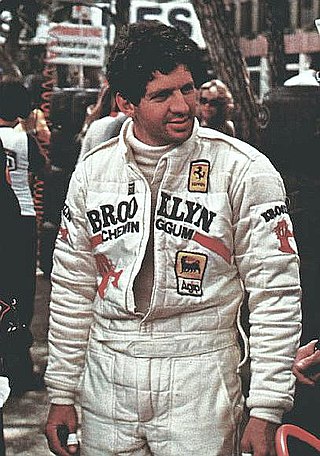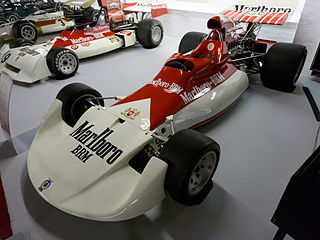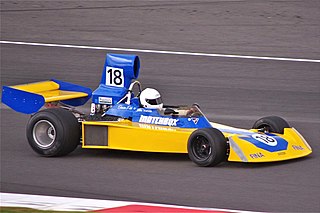Racing history
1973
The FX3B was used for the first three races of the 1973 season, and had been driven by New Zealander Howden Ganley and Italian Nanni Galli, although Jackie Pretorius had filled in at the South African Grand Prix when Galli was injured. The new IR appeared at the fourth race of the season, the Spanish Grand Prix, with Ganley and the returning Galli at the wheel. Qualifying on the last two rows of the grid, the Italian finished 11th while Ganley retired when he ran out of fuel. [7] Both drivers retired in Belgium, through an engine failure for Galli and an accident for Ganley when his throttle stuck. [8] Both drivers retired with half-shaft failures at the Monaco Grand Prix, although Ganley had qualified tenth fastest, [9] and after the race Galli left the team and announced his retirement from Formula One. [10]
Tom Belsø replaced Galli in Sweden but he only took part in practice (and was slowest) as it appeared no funding was available from his sponsors for the race. Ganley crashed in the warm-up and finished eleventh in the car Belsø had used. [11] The car had received a new cooling system before this race. [12] Henri Pescarolo returned to replace Belsø for the French Grand Prix, but retired with overheating problems while Ganley finished 14th. [13] Graham McRae replaced Pescarolo for the British Grand Prix, qualifying on the back row, but he retired with a throttle problem on the first lap, while Ganley started 18th and finished ninth. [14]
Williams continued to rent out the second IR to paydrivers, and Gijs van Lennep replaced McRae for the Dutch Grand Prix. In a race overshadowed by the death of Roger Williamson, van Lennep finished sixth, two laps down, with Ganley ninth. This race marked the first World Championship point scored by an Iso–Marlboro. [15] Pescarolo returned for the German Grand Prix, qualifying 12th and finishing tenth, but Ganley crashed heavily in practice due to brake problems, writing off the chassis. [16] A replacement was quickly built (and given the same chassis number "02"), and Van Lennep returned for the Austrian Grand Prix. The Dutchman put in another good performance finishing ninth, but Ganley was ten laps down and not classified. [17] In Italy, Ganley was eleven laps down and was again not classified, and Van Lennep retired with overheating. [18]
Another new driver, the Australian Tim Schenken, replaced van Lennep for the Canadian Grand Prix. The race began in very wet conditions, which caused a number of incidents later in the race, and for the first time in Formula One history a safety car was deployed, [19] although the sport would wait until 1993 before giving an official role to these cars. The car in question was a Porsche 914 driven by former Formula One privateer Eppie Wietzes. [20] Wietzes failed to pick up the leader, staying in front of Ganley by mistake, which allowed several drivers including eventual winner Peter Revson to gain a lap on the field. [21] In the subsequent confusion, some believed the leader to be Ganley, and others including Team Lotus manager Colin Chapman were sure it was Emerson Fittipaldi. The race order was in chaos, but when the safety car withdrew, Ganley's IR was leading the race. "As they thought I was in front I decided perhaps I'd better try and stay there," said Ganley afterwards, and he led Fittipaldi and Jackie Stewart for eight laps. [6] [22] After both had passed him, Ganley continued to battle with Stewart, Mike Hailwood, Revson and James Hunt until the end of the race. Fittipaldi crossed the line but the chequered flag was not waved; instead it was waved at Revson, with Ganley sixth, earning his first and the team's second World Championship point of the season. Schenken finished 14th, five laps down. [23] Lap charts differed, but some (including the team's chart, kept by Ganley's girlfriend) suggested that Ganley had won the race. "I believed I should have finished either first or third," he later said. [24]
Jacky Ickx replaced Schenken for the season-ending United States Grand Prix and drove well to finish seventh with Ganley 12th. [25] This was the final race for the car under the IR designation, and it had scored two points, leaving Williams tenth in the Constructors' Championship standings.
1974
After backers Iso and Marlboro left before the 1974 season, the slightly revised car was renamed the Iso–Marlboro FW, and Frank Williams found that he was underfinanced. At first therefore, a single car (chassis "02") was entered for former Ferrari driver Arturo Merzario, who had replaced Ganley as the team's number one driver. At the season-opening Argentine Grand Prix, the Italian qualified 13th but retired with overheating problems. [26] In Brazil, Merzario qualified ninth but his engine failed before the start and he had to race in the spare car. He retired after 20 laps with a throttle problem. [27]
At the South African Grand Prix, Williams entered a second car (chassis "01") for Tom Belsø, who qualified last with Merzario an outstanding third on the grid. The Dane retired on lap 1 with a slipping clutch but Merzario finished sixth, earning the team their first World Championship point of the season. [28] A new third chassis ("03") was completed at this time, allowing for a spare car (usually "01"). In Spain Belsø was slowest in practice and failed to qualify and Merzario started seventh. He raced well and was lying fourth when he went off the track on lap 38; his car went over the barriers, landing among a group of photographers, fortunately with no injuries. [29]
Gijs van Lennep returned for the Belgian Grand Prix, replacing Belsø, but the Dutchman qualified on the back row with Merzario seventh. Van Lennep finished 14th but Merzario retired with a broken driveshaft. [30] The entry for the Monaco Grand Prix was cut back, and only Merzario raced, but he retired after a multiple accident at the start. [31] Before the Swedish Grand Prix, Merzario had broken a finger in a sports car crash, and after a few practice laps, he decided against racing in Sweden. British driver Richard Robarts was scheduled to substitute for him alongside the returning Belsø, but the Dane damaged his car in practice and ultimately raced Robarts' car instead. [32] Belsø qualified 21st and finished eighth, the best result of his career. [33] [34]
A disappointing mid-season period followed with a string of non-qualifications for the second FW as the "01" chassis had to be used again due to accidents. Van Lennep returned for the Dutch Grand Prix but failed to qualify and Merzario retired with a broken gearbox, having qualified down in 21st. [35] For the French Grand Prix, Jean-Pierre Jabouille was brought in to replace the Dutchman but he also failed to qualify (the last appearance for chassis "01"), while Merzario started 15th and finished ninth. [36] Belsø returned again for the British Grand Prix, although Jabouille also practiced, but the Dane failed to qualify. Merzario again started 15th but retired when his engine failed. [37]
Subsequently, Frenchman Jacques Laffite took the second Williams seat for the remainder of the season. He qualified the car in 21st place for the German Grand Prix with Merzario 16th, although both retired early in the race; Laffite with suspension failure and Merzario with a throttle problem. [38] In Austria, qualifying improved with Merzario ninth and Laffite 12th, but the Italian retired with a fuel system problem and Laffite was unclassified at the end, seventeen laps down. [39]
The team's fortunes turned at the Italian Grand Prix. Although Merzario and Laffite started in the midfield, 15th and 17th respectively, and Laffite retired with an engine failure, Merzario finished fourth, scoring three World Championship points. [40] This ultimately marked the car's best result under any of its three designations. In Canada their form dipped again with both cars qualifying in the lower midfield, and a double retirement. Merzario retired at half-distance with handling problems and the Frenchman was classified 15th after dropping out with a puncture. [41] At the season-ending United States Grand Prix, Laffite outqualified Merzario for the first time (11th and 15th), but Laffite retired and Merzario followed him when his onboard fire extinguisher deployed and the engine cut out. [42] This was the last race for the car as an Iso–Marlboro.
The Williams team had scored four World Championship points, earning them tenth place in the Constructors' Championship for the second season running.
1975
The three remaining FW chassis were renamed the Williams FW for 1975, and revised by Ray Stokoe, but by now the design was becoming outdated. They were resdesignated the FW01, FW02 and FW03 despite being of the same type. The oldest car, the FW01 (original IR chassis "01") continued to be used only as a spare car, and the FW02 (IR chassis "02") was only used for the first three races of the season. The team used the slightly newer FW03 throughout 1975 while they worked on a replacement, the FW04, which was ready for the Spanish Grand Prix. Williams was operating on a low budget and was occasionally even forced to buy used tyres from other teams. [43] Both Merzario and Laffite stayed with the team for 1975.
Williams began the season with Laffite driving the FW02 and Merzario in the FW03. They qualified for the season-opening Argentine Grand Prix in 17th and 20th respectively, and Laffite retired from the race with a broken gearbox. Merzario finished eleven laps down and was not classified. [44] In Brazil, Merzario started 11th but retired from the race with a fuel system problem, while Laffite started 19th and finished 11th. [45] In the final World Championship race for the FW02, the South African Grand Prix, Laffite started 23rd and was unclassified at the end of the race, nine laps down. Merzario qualified the FW03 in 15th place but retired with engine failure. [46]
Two non-championship races took place at this time; firstly the 1975 Race of Champions, in which Williams entered the FW02 for Maurizio Flammini, who crashed it in practice and did not start the race. Merzario drove the FW03 to seventh place. [47] At the 1975 BRDC International Trophy, Merzario drove the FW03 but failed to start after engine problems. [48]
At the Spanish Grand Prix, the young British driver Tony Brise replaced Laffite who was driving in Formula Two that day. Brise drove the FW03, outqualified Merzario who drove the new FW04 (18th and 25th), and went on to finish seventh in the race. Merzario withdrew from the race protesting that the barriers were not bolted together properly. Later Rolf Stommelen's rear wing failed and he crashed into the crowd, killing five people. [49] In Monaco, the grid was cut to just 18 cars after the accident in Spain, and Merzario failed to qualify the FW03 in 20th place. [50] At the Belgian Grand Prix Merzario retired the FW03 with clutch failure on lap 2, and he subsequently left the team. [51] In Sweden, Laffite was also absent, driving in Formula Two again, so Damien Magee was brought in to drive the FW03. He qualified 22nd and finished 14th while Ian Scheckter crashed out in the FW04. [52]
Scheckter took over from Magee in the FW03 for the Dutch Grand Prix while Laffite drove the FW04 for the rest of the season. Scheckter qualified 19th and finished 12th. [53] The FW03 was subsequently driven by a string of drivers on one-race deals, and results were poor. François Migault qualified down in 24th for his home race in France but failed to start after engine trouble. [54] Jean-Pierre Jabouille was entered in the FW03 for the British Grand Prix but did not drive after Williams ran short of engines, [55] and Ian Ashley crashed the FW03 heavily during practice for the German Grand Prix and suffered serious ankle injuries which led to him not starting. Laffite secured a surprise second place in the FW04, bringing a much-needed financial boost to the team. [56]
With the FW03 repaired, Jo Vonlanthen was signed to drive in Austria, and he qualified down in 28th position. He retired from the race with engine failure. [57] Vonlanthen also drove the FW03 in the non-championship Swiss Grand Prix, starting on the back row and finishing unclassified, nine laps down. [58] Renzo Zorzi replaced him for the Italian Grand Prix, qualifying 22nd and finishing 14th. [59] The FW03 was finally retired before the season-ending US Grand Prix, as a second FW04 had been built, although both cars failed to start. [60]
Williams finished the season in ninth place in the Constructors' Championship with six points, although all had been scored by the new FW04.



















